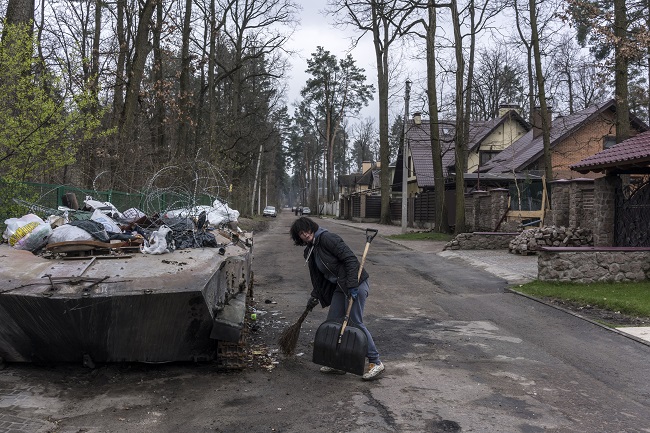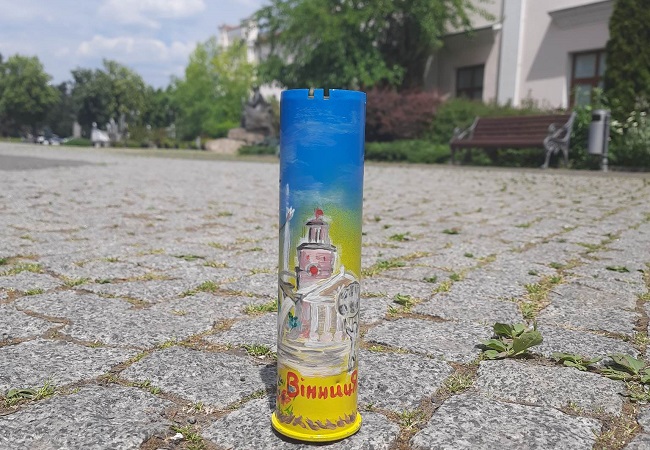Citizen archaeologists asked to help collect conflict heritage in Ukraine
Published: 18 March 2024
Academics in Ukraine and Scotland are launching a mass crowdsourcing project to help record conflict heritage and testimonies of people impacted by war.

Academics in Ukraine and Scotland are launching a mass crowdsourcing project to help record conflict heritage and testimonies of people impacted by war.
The project entitled “The war spoke to us noisily with explosions and quietly with things” is a partnership between the Archaeology Department, National University of Kyiv-Mohyla Academy (NaUKMA) and The Scottish Centre for War Studies & Conflict Archaeology, University of Glasgow.
In February 2022, Russia launched a full-scale invasion of Ukraine. Two years later, the war is still ongoing, and millions of people been affected, and along with the terrible toll of dead and wounded, homes, public facilities and school buildings have been destroyed.
Now this new project is calling on Ukraine’s citizens to become conflict archaeologists and help crowdsource images of the by-products of war, as represented by the modified use of material culture and the altering of spaces, with the addition of personal testimonies from Ukrainians further contributing to a better understanding of how the civilian population is responding to the war in real time.
This Ukraine-wide initiative follows on from a limited pilot study where students and researchers in NaUKMA gathered images of how the war was impacting on ordinary people. The pilot showed examples of how citizens were using their personal spaces to create features such as memorial gardens and how material culture was being put to new uses – a striking example of this was a woman disposing of rubbish into the open hull of a burned out Russian armoured vehicle, which was now being used as a skip. It also recorded how local artists created striking artworks from shell casings and jewellery from melting down spent bullets.
Memories of those involved in wars are usually captured long after the conflict is over, but this project seeks to gather these testimonies and uses of the material culture of war as events unfold. Important tools in gathering information will be social media platforms such as X (formerly Twitter), Facebook and Instagram.
The project grows out of a twinning agreement between Kyiv and Glasgow along with a direct approach from Dr Oleh Bilynskyi, an Associate Professor at NaUKMA to Professor Tony Pollard and Dr Iain Banks in the Scottish Centre for War Studies and Conflict Archaeology at Glasgow.
Dr Oleh Bilynskyi Associate Professor, Head of Archaeological department at NaUKMA, who is co-lead of the project in Ukraine said: “Throughout human history, many societies have faced massive wars, and each of them experienced it in its own way, adapting to new conditions and discovering previously unknown feelings - courage, love, hatred, and more. This war has been going on for 10 years and threatens not only the integrity of Ukrainian territory but also its culture and identity.
“In such situations, the concept of identity presents itself to us from a new, previously unknown side. All of this is reflected, including in things and spaces that surround people. They change their functions and integrate from one sphere of life to another. Shells from artillery projectiles become ashtrays, flower beds cover trenches, satellite internet terminals become elements of military vehicles, and explosives are attached to wedding drones. Archaeology has developed a rich toolkit for researching things and spaces where people live, and in such a situation, the use of its methods allows us to complement our understanding of how humanity experiences war. This shows the specific aspects of Ukrainian identity, how our society copes with such challenges. Recording these features allows us not only to study but also to preserve Ukrainian identity and culture.”
Diana Nahirna, Psychologist working with people affected by the war, who is co-lead of the project in Ukraine, said: “Recording the material culture of an ongoing war and seeking to uncover the human experience behind it is a great challenge in terms of methodology, security, and interpretation. It can also have an emotional toll, since we are working with struggle, loss, trauma, dangers, and uncertainties. My role is to support the participants, academics and students who are processing the often painful stories behind those objects of war, fostering resilience and helping make sense of the new reality. Growing beyond adversity starts with telling your story. Our hope is to understand and amplify their voices, to preserve the memory of the war, to help find meaning and heal.”

Tony Pollard, Professor of Conflict History and Archaeology, who is co-lead on the project at Glasgow, said: “It’s a privilege to help develop this project with our Ukrainian colleagues and share our long experience in the field of conflict archaeology. I am currently researching the impact of war and its aftermath on the use of material culture across both time and space and this initiative represents a unique approach to this type of study, where data is collected and observations made while a conflict is underway. It is hoped that this sort of information will help us to understand the impact of war on a population, and once the war is over even playing a part in the recovery and repair of both people and things (I have just returned from Vietnam where I have been looking at how that previously war-torn country has used the legacies of war in these processes). My only regret in relation to the project, beyond the suffering and upheaval caused by the war in the first place, is that we cannot be in Ukraine offering direct support and assisting with the data collection, but this is their project and we are here to help in any way we can.”
Dr Iain Banks, Senior Lecturer in History and Archaeology, who is co-lead on the project at Glasgow University, said: “It is not often that we get the chance to study conflict while it is happening, and this is an opportunity for us to examine the impact of the war on the population as a whole, and to understand the material culture that emerges from the conflict. Most importantly, it means that the project will be in the voice of Ukrainians themselves, rather than a purely outside view from external academics. This project ties in with research I am carrying out with colleagues in Finland about the impact of WWII on the population; it is an amazing opportunity to bring together experiences from 80 years ago with current experiences, albeit a tragedy that 80 years on, we are doing the same things again.”
The war spoke to us noisily with explosions and quietly with things project - Social Media
Instagram - https://www.instagram.com/war_spoke_to_us/
Facebook - https://www.facebook.com/profile.php?id=61552236901547
Telegram - https://t.me/war_spoke_to_us
X - https://twitter.com/war_spoke_to_us
Email - kmaugwarstudyproject@gmail.com
UK-Ukraine University #TwinforHope Initiative
As part of the UK-Ukraine University #TwinforHope Initiative, in March 2023, the University of Glasgow (UofG) and National University of Kyiv-Mohyla Academy (NaUKMA) were awarded funding via Universities UK International (UUki) to support research and innovation.
Learn more here
First published: 18 March 2024
<< March

